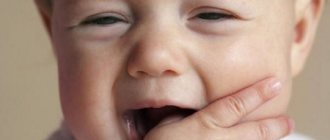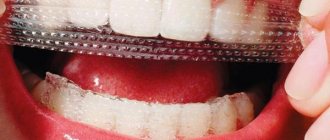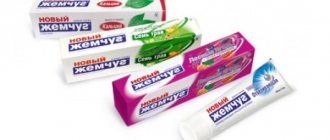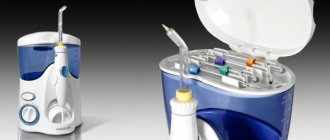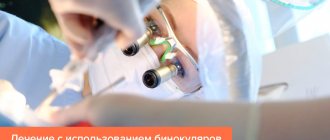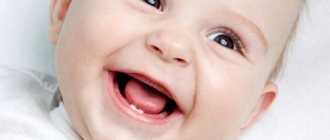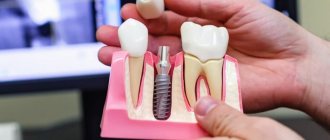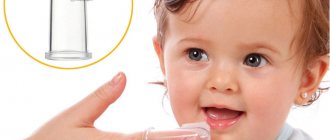The appearance of a baby's first teeth is often accompanied by painful sensations. You can alleviate the child's suffering by using special medical ointments for teething or home remedies. Typically, the first baby teeth erupt before the baby is 9 months old. Most often, this event is accompanied by discomfort, sleep disturbance, moodiness and other unpleasant symptoms. Parents are beginning to look for effective methods that will help the baby alleviate his condition and make the teething period more comfortable.
One of the most effective and popular are pain-relieving gels that are applied to the gums. However, before using them, you need to make sure that they are safe and optimal for use in a particular case.
Characteristics of the drug
The drug is available in gel form. It is a homogeneous colorless mass with the smell of anise oil. There are packages of 10 and 15 g. Manufacturer: Polish pharmaceutical plant Elfa. The product contains the following active ingredients:
- choline salicylate;
- cetalkonium chloride.
One of the active ingredients of the drug is choline salicylate. This substance has a local analgesic, antipyretic and anti-inflammatory effect. The component also destroys fungi, including the genus Candida.
Due to the presence of cetalkonium chloride in the composition, the medicine has an antiseptic effect. The analgesic effect is observed 2-3 minutes after application of the product and lasts up to 8 hours. In addition to the main active ingredients, the product contains auxiliary components:
- glycerol;
- anise oil;
- purified water;
- ethanol;
- glycerol;
- methyloxyenzoate;
- Hydroxyethylcellulose.
The medication does not contain sugar and is well tolerated. Its active substances are quickly absorbed into the mucous membranes. Due to this, the fastest possible effect is achieved. If it is not observed, the inflammatory process has spread as deeply as possible and cannot be eliminated by local means.
The child is teething... How to help?
There is a popular saying: if a child is actively drooling, it means that his first teeth will soon appear. My personal experience does not confirm this wisdom. From two to three months everyone starts drooling, and teeth appear, as a rule, after six months.
The time for teeth to appear (with normal nutrition and care) depends mainly on heredity - of course, within certain limits. There is no reason to worry if everything is absolutely normal, the child is nine months old and has no teeth.
It simply doesn’t happen that teeth don’t grow at all. But no way to influence the timing of teething.
And there is no relationship between the state of the child’s health and the timing of teething. So there is no need to be nervous and worry in vain!
A deviation from the average teething norms of 6 months in one direction or another is considered normal!
Teeth cutting in the “wrong” sequence is not a sign of illness!
There are no medications that can affect the timing and sequence of teething!
However, there are a huge number of medications in the form of pleasant-tasting gels that are rubbed on a child’s gums, thus facilitating teething.
Such gels are divided into two groups - those containing a local anesthetic (usually benzocaine or lidocaine) and those not containing it.
Medical science strongly does not recommend the use of gels with benzocaine or lidocaine, as they provoke deadly complications, especially seizures and heart rhythm disturbances.
Carefully study the instructions for dental gels! If you find the word “benzocaine” or “lidocaine” in the product, do not buy it!
***
And now just some useful information.
The order of the teeth is recorded in the form of a dental formula. Individual teeth are designated by numbers. Each tooth has its own serial number, and the countdown starts from the center. The two rows of numbers in the dental formula correspond to the teeth on the upper and lower jaw.
| Age | Dental formula |
| 6–7 months | |
| 1 1 | |
| 8–9 months | 1 1 |
| 1 1 | |
| 10 months | 2 1 1 2 |
| 1 1 | |
| 12 months | 2 1 1 2 |
| 2 1 1 2 | |
| 12–15 months | 3 2 1 1 2 3 |
| 3 2 1 1 2 3 | |
| 18–20 months | 4 3 2 1 1 2 3 4 |
| 4 3 2 1 1 2 3 4 | |
| 20–30 months | 5 4 3 2 1 1 2 3 4 5 |
| 5 4 3 2 1 1 2 3 4 5 |
And one moment. Medical science believes that teething is very rarely accompanied by the development of a painful condition. But both practicing doctors (including the author) and the overwhelming majority of parents often observe how a seemingly healthy child suddenly, for no reason at all, deteriorates in mood, the temperature rises, and sometimes diarrhea begins. And after two or three days the tooth erupts, and everything goes away.
Symptoms of teething often include very severe itching of the gums, to satisfy which the baby pulls into the mouth everything that can be stuffed there.
It is not surprising that when a child is teething, the likelihood of swallowing a foreign body, getting a foreign body into the respiratory tract, and even the risk of intestinal infections increases significantly.
A safe, inexpensive, pleasant and effective method of assistance, highly recommended in the described situation, is the use of special teethers.
A teether is a wonderful device used, as the name suggests, during the teething stage. The teether safely relieves pain and itching of the gums, because you can gnaw and bite without any restrictions. The analgesic effect can be enhanced by pre-cooling the teether in the refrigerator or cold water.
You should know that teethers:
- made of rubber, silicone, latex, plastic, even wood;
- They often have a special shape designed to help with the eruption of certain teeth - lower anterior, upper anterior, lateral. But most often, teethers are universal, and this is written on the packaging;
- they often have bumps on the part that enters the mouth, allowing them to effectively massage the gums;
- As a rule, they are produced in a form resembling a ring, and this ring is convenient for a child to hold, chew, and examine.
Continuing the conversation about teeth, we note that there is no need to put off teaching your child to brush them until later. The first teeth have appeared - let's start brushing them! Moreover, the main attention should be paid not to care products (toothpastes, powders), but to the process itself, the need to brush your teeth with brushes. It is most convenient to begin this training in the bathroom - as a rule, the time when the child begins to sit in a large bathtub and the time when his first tooth appears coincides.
A special finger brush, as the name suggests, is placed on mom or dad’s finger and the exciting game of brushing your teeth begins. Your child will understand the rules of the game much faster if he sees you brushing your teeth.
The process of brushing teeth with a brush placed on the parents’ finger, as a rule, does not last long, since the child quickly develops a desire (reinforced by the opportunity) to do it on his own, especially if he constantly sees mom and dad doing this activity. This is where it comes time for your first personal brush. The first toothbrush should look something like the picture below. Its fundamental feature is a special limiter that regulates the depth of immersion in the mouth.
The first tooth, which most often appears around 6 months, also signals the baby’s readiness for complementary feeding. And during this fascinating process, you will definitely need a wonderful device with a name that is still unusual for our ears - a nibbler. Using a nibbler is very convenient to introduce your child to various vegetables and fruits. Moreover, the use of fruit juices, especially ready-made ones produced industrially, is not actively recommended by modern medical science.
Giving fruit juices to children is a tradition favored by the majority of the population, but needs to be re-evaluated because fruit juices contain excess calories and sugar and are low in nutritional value. As a result: the child willingly drinks sweet juice, instead of receiving truly healthy natural fruits and other foods containing carbohydrates, proteins, fats, fiber, calcium and other macro- and microelements.
So, the nibbler is a wonderful device for feeding a baby. It is a nylon mesh or silicone nozzle with numerous holes, attached to a base with a handle. Products used for complementary feeding are placed in the nibbler - usually vegetables, fruits, berries, and somewhat less often - bread, cookies, crackers, hard cheeses, etc. The child absorbs (softens) the contents of the nibbler and gets acquainted with new tastes without risk choke.
And a nibbler with chilled contents (for example, an apple straight from the refrigerator) is a wonderful way to relieve itchy gums during teething.
Also, with the help of a nibbler, you can introduce your child to a variety of tastes and foods early enough, and this, according to modern scientists, greatly reduces the risk of developing food allergies.
Just remember the main rule: thoroughly washing out food debris from the mesh and holes is the most important condition for the safe use of the nibbler.
All these very necessary items are included in the Tiny “First Tooth” set. But this is not just a set of individual products - it is a continuation of Dr. Komarovsky’s ideology to preserve the health of your child.
Each of the items is the result of careful selection, testing and scrupulous analysis of what the baby and his parents really need.
The contents of the set clearly correspond to the name - two teethers, finger toothbrushes (two sizes), the first individual toothbrush and a nibbler.
I think that once you start using all the items, you will appreciate this gift for mothers from Dr. Komarovsky.
author Komarovsky E.O. published 29/03/2018 17:57 updated 25/10/2020 — Lifestyle, Family
Indications for use and contraindications
Dental gel Cholisal is intended for topical use. It is prescribed for damage to the mucous membranes of the oral cavity, periodontal disease and inflammation accompanied by pain. Indications for use:
- stomatitis, regardless of etiology;
- periodontitis;
- gingivitis;
- gum injuries due to wearing dentures;
- pain during teething in infants older than 6 months;
- candidiasis;
- radiation dermatitis after radiation therapy;
- cheilitis;
- tooth extraction or other surgical intervention in the oral cavity;
- lichen planus, localized on the oral mucosa;
- exudative erythema.
The drug is contraindicated in case of hypersensitivity to its components. Use with caution in children under one year of age, pregnant and lactating women. Salicylic acid derivatives pass into breast milk and are contraindicated in the third trimester of pregnancy.
Experts' opinion
The ASEPTA series of products is characterized by clinically proven effectiveness. The results of studies of toothpastes, napkins, rinses, balms and other ASEPTA products are regularly published on our website. The effect of the products produced is tested in our own laboratory at the VERTEX research center. All products have certificates of conformity.
Sources:
- Report on determining/confirming the preventive properties of toothpaste “ASEPTA PLUS” GENTLE WHITENING” Author: doctor-researcher A.A. Leontyev, head Department of Preventive Dentistry, Doctor of Medical Sciences, Professor S.B. Ulitovsky First St. Petersburg State Medical University named after. acad. I.P. Pavlova, Department of Preventive Dentistry
- Report on the determination/confirmation of the preventive properties of personal oral hygiene products “ASEPTA PLUS” Remineralization doctor-researcher A.A. Leontyev, head Department of Preventive Dentistry, Doctor of Medical Sciences, Professor S.B. Ulitovsky First St. Petersburg State Medical University named after. acad. I.P. Pavlova, Department of Preventive Dentistry
- Clinical experience in using the Asepta series of products Fuchs Elena Ivanovna Assistant of the Department of Therapeutic and Pediatric Dentistry State Budgetary Educational Institution of Higher Professional Education Ryazan State Medical University named after Academician I.P. Pavlova of the Ministry of Health and Social Development of the Russian Federation (GBOU VPO RyazSMU Ministry of Health and Social Development of Russia)
Features of application
The product should be smeared onto the affected areas and rubbed in with gentle massaging movements for about 2 minutes. Apply the gel 2-3 times a day. It is applied before or after meals, and can also be used before bed.
You should not eat or drink for half an hour after applying the drug.
Before applying the product, the oral cavity is prepared. The internal mucous membranes and gums are dried with a cotton-gauze pad. The product is squeezed onto a clean finger. For adults, a strip 1 cm long is enough.
The product is applied to the tissue at the edges of the tooth and papilla. They cover the front and back parts of the dentition. The lingual side is also treated.
The instructions for using Cholisal for periodontal disease are somewhat different. It is placed 1-2 times a day directly into the gum pockets. They also make compresses or rub the drug into the gums. Such procedures are carried out after eating, having previously disinfected the oral cavity with an antibacterial rinse.
It is better not to hold your breath during the procedure, but to breathe deeply.
Cholisal provokes excessive salivation. The resulting saliva is not spit out. It must be swallowed as it accumulates. There is no need to wipe the mucous membranes with a cotton pad or napkin.
Use for teething
It is allowed to use the gel during teething from the age of six months. A strip 0.5 cm long is used at a time. It is strongly not recommended to exceed this dosage.
Before the procedure, the mucous membranes are dried with a cotton pad. Only after this the gel is applied to the inflamed areas. It is rubbed into the baby's mucous membranes with gentle circular movements, without applying excessive force.
After applying the drug, you need to keep the child in a horizontal position so that he does not choke on saliva.
You can use the medicine for teething a maximum of 3 times a day. The interval between procedures should be at least 4 hours.
The analgesic effect is observed 3 to 5 minutes after application of the product and lasts from 2 to 8 hours. The course of treatment ends immediately after pain is eliminated.
How to massage your child's gums?
In order for gum massage during teething to be effective and in no way harm the baby, it is important to do it correctly and technically.
- First, the massage therapist needs to wash his hands thoroughly with soap. It is not recommended to treat your hands with alcohol or other antibacterial compounds before touching your child's gums. If you do decide to treat your hands, be sure to rinse them with water after this procedure.
- You need to run your finger back and forth along the gum, exerting gentle pressure on the tissue. Don’t worry if your baby closes his mouth during the massage—it’s not in any danger to you or him. It is important not to hesitate, but to continue leisurely movements.
- The massage can be carried out until the baby stops being nervous.
You can massage the gums during teething using a gauze swab dipped in boiled cool water. The massage technique with a gauze pad is no different from manipulations performed with a finger. When wrapping the finger in gauze, parents should be careful not to put too much pressure on the gum. Cool water will provide the gums with an additional cooling effect and relieve pain.
Side effects and overdose
There were no cases of overdose with this drug. If this happens, you should immediately rinse your mouth with clean water. If necessary, vomiting should also be induced. If you are hypersensitive to salicylates, the following changes are possible:
- excessive sweating;
- gagging;
- nausea;
- tinnitus;
- urticaria or erythema;
- dizziness.
Side effects are extremely rare. A short-term burning sensation may occur after applying the gel. Unpleasant sensations disappear on their own after 3-5 minutes. It is also possible that an allergic reaction may develop.
Possible complications
If you do not follow the rules of use specified in the instructions, you can get side effects from using painkillers gels. The most common consequences are:
- the occurrence of allergies;
- skin rashes;
- inflammatory processes in the gums.
Redness on the cheeks, roughness of the skin, and rashes on the skin are a possible allergic reaction to the use of dental gel.
special instructions
The drug is intended exclusively for topical use. It cannot be taken orally. The medicine does not affect the ability to operate machinery or drive vehicles. There is also no limitation of physical activity.
For long-term and short-term treatment, it is not recommended to use Cholisal simultaneously with other antibacterial agents. The medication combines well with other drugs. No obvious incompatibility was identified.
If the permissible dosage is increased excessively, Cholisal can enhance the effect of other painkillers, antipyretic and anti-inflammatory drugs.
If the recommended dose is observed, such an effect is not observed.
The gel cannot be frozen or stored in the refrigerator.
The optimal storage temperature is 25 °C. The medicine should be kept out of the reach of children. The shelf life of the medicine is 3 years. After opening the tube, the gel is stored for no more than 2 weeks. The duration of continuous therapy should not exceed 10 days.
Possible consequences of use
The medication contains anise oil, which can cause excessive salivation. For adults, this phenomenon does not pose any danger. With young children the situation is somewhat different.
Infants cannot yet swallow all the saliva that is released. Liquid begins to flow out of the mouth, causing irritation of the skin. The child may choke and begin to cough heavily. Therefore, the topical remedy should be used with caution.
Negative changes are also observed if the rules for using the medicine are not followed. The most common violation is neglect of sterility. If the medication is applied with dirty hands, there is a risk of infection.
Naturally, this does not bring relief. The condition is getting worse. Additional antimicrobial therapy is required. The course of treatment will be longer.
Benefits of Cholisal gel
The popularity of the product is due to the fact that it has many advantages. The medication acts quickly and can eliminate pain in a matter of minutes. In addition, among its advantages are the following:
- Long lasting. If you apply the product before bed, pain will not occur until the morning.
- Thick consistency. The medicine does not spread and adheres well to the mucous membranes.
- Penetration into the deep layers of inflamed tissue.
- Pronounced anti-inflammatory effect.
In addition, Cholisal destroys many pathogenic microorganisms. Therefore, it is used for inflammatory processes of various etiologies. This is an effective medicine in the fight against thrush and herpes.
Disadvantages of the medication
No matter how effective this drug is, it has certain disadvantages. For example, for a tube of small volume you will have to pay a relatively large amount. In addition, among its disadvantages:
- Pronounced aroma and taste of anise. Due to this, salivation often becomes abundant, and the mucous membranes of the oral cavity become irritated.
- Presence of contraindications.
- Possible side effects.
No other shortcomings have been identified in Kholisal. It has proven itself to be an effective and efficient drug. Most often it is well tolerated.
Actions in case of eye contact
When using the gel, unexpected situations may arise. For example, the product accidentally came into contact with the mucous membranes of the eye. In this case, you need to urgently take the following measures:
- Rinse your eyesight with plenty of water. It should be cold, but boiled.
- Rinse for at least a quarter of an hour. This will be enough to completely wash the product.
- Blot mucous eyes with a napkin.
- Place anti-inflammatory drops into both eyes. Sulfacyl sodium, Levomycytin and their analogues can be used.
After washing the eye, it is allowed to use ointments rather than drops. They are applied to the lower eyelid. Excellent results are observed when using Hydrocortisone ointment. After such procedures, it will be possible to eliminate redness, swelling and burning.
List of analogues and substitutes
Cholisal costs about 450 rubles in pharmacies. If you wish, you can find cheaper analogues. There are many drugs that have a similar effect. They can also be used for pain relief during teething in children.
| A drug | Active substance | Manufacturer | Price |
| Kamistad | laureth-9 and chamomile extract | STADA Arzneimittel AG, Germany | 300 rubles |
| Dentol baby | benzocaine | PHARMACEUTICALS INC., Canada | 200 rubles |
| Kalgel | cetilleridine chloride and lidocaine | Glaxosmithkline, UK | 350 rubles |
| Metrogil Denta | metronidazole benzoate | Unique Pharmaceutical, India | 230 rubles |
| Solcoseryl | solcoseryl | MEDA Pharmaceuticals, Switzerland | 640 rubles |
| Baby Doctor First teeth | herbal extracts | Hatzi Hazakot, Israel | 350 rubles |
| Dentinox | lidocaine hydrochloride and chamomile extract | Dentinox, Germany | 370 rubles |
The difference between these drugs is not only in the active ingredient and price. It is problematic to say unequivocally which one is best to use to eliminate pain. Each of them has its own advantages and disadvantages.
Review of the most popular tools
The range of pain relief products is quite wide, and choosing what to smear your gums with when teething can be difficult. The most common are seven drugs, which are discussed below. Cholisal Has an anti-inflammatory and analgesic effect, reducing swelling of the gums. It is resistant to saliva and continues to act for 8 hours. The product has an antibacterial and antiviral effect, preserving the natural microflora of the oral cavity. The advantage of the drug is the absence of lidocaine, which makes it possible to use even during breastfeeding, since the sensitivity of the tongue is completely preserved. The average price is 280 rubles. Dentinox Gel has a local anesthetic effect, quickly and effectively relieving painful sensations during dental procedures.
Important! The drug has an anti-inflammatory effect due to the chamomile extracts and other components it contains. The gel is used for children of different ages. The product contains lidocaine, therefore it has restrictions for use during breastfeeding.
The possibility of an allergic reaction should also be taken into account.
The cost of the drug is about 320 rubles. Baby Doctor A preparation based on extracts of chamomile, echinacea, calendura and plantain. The product has an anti-inflammatory and antibacterial effect, promotes healing of wounds on the gums and relieves irritation, relieves pain. The advantage of the product is its completely natural composition, however, the analgesic effect may be insufficient. The price of the product is about 320 rubles. Kalgel This gel contains lidocine hydrochloride, which provides a quick anesthetic and cooling effect. The product instantly helps relieve teething symptoms. The quickly achieved result, however, does not last long - about half an hour. The average cost of the gel is 340 rubles. Kamistad A complex product that combines anesthetic components, as well as a medicinal chamomile extract that has an antiseptic, healing and anti-inflammatory effect. The advantage is the fast and long-lasting effect of the gel, but the disadvantage is the content of lidocaine in its composition. The price of the drug is about 220 rubles. Pansoral The plant components of the product effectively soothe and soften the gums. The completely natural composition is the main advantage of the drug. The downside is the weak anesthetic effect. The average price for the product is about 360 rubles. Dentol-baby Gel has a very fast analgesic effect that lasts for two hours. Contains benzocaine. The disadvantages include a relatively short period of pain relief, but the advantage is the speed of action of the drug. The average market price of the gel is 180 rubles.
This image shows some of the most common products that facilitate the process of teething: Dentol, Cholisal, Kamistad, Dentinox, Baby Doctor, Kalgel.
Cholisal or analogue: what to choose?
The Polish drug Cholisal has established itself as an effective pain reliever. The gel has a complex effect and eliminates many problems. The medication not only relieves pain, but also eliminates the inflammatory process and destroys pathogenic microorganisms.
This medicine can be used for teething in children. He is able to quickly cope with the task and eliminate pain. Other medications also have a similar effect.
The choice of one medication or another is a purely personal matter. Cholisal is considered one of the best dental medicines. Therefore, it is often used. If the child has not yet reached six months of age and has increased sensitivity to the components of the gel, it is better to choose another medication.
Also, preference should be given to analogues if side effects occur after using Cholisal. For example, vomiting or dizziness. This is an extremely rare phenomenon, but it cannot be completely excluded.
In such cases, you can do without additional funds.
Unfortunately, for many children, using this method is not enough. They are capricious, sleep poorly, lose their appetite and do not leave their parents' arms. In such a situation, you should not force the child to endure, but it is better to save his nervous system by providing assistance with the help of special children's gels for gums. They have a pronounced anesthetic effect and have a minimum of contraindications. When choosing a product, it is worth considering that some gels (usually containing lidocaine) can, when they come into contact with a child’s tongue, cause numbness and make it difficult to suck during breastfeeding.
Additional products are gels containing antiseptic, anti-inflammatory, homeopathic components, suggesting the possibility of a combined effect on the child’s body, this ensures that the process of tooth growth ceases to disturb.
In general, during the dental period you should be more attentive and tolerant to the baby. If you play with your child more often, hold him in your arms, put him to your breast (when breastfeeding), practice co-sleeping, then it will be much easier for your child to get through this difficult time.
